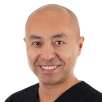Many have now accepted The Myobrace System is peerless in terms of the potential to cajole the orofacial muscles into widening arches and allowing good dental alignment. There exists a common misconception amongst dentofacial orthopedists, however, that although The Myobrace System is proficient at straightening teeth, traditional functional appliance systems are better for facial development.
This was a belief to which even I subscribed before I began to actually use the system myself. Although I paid lip service to role of muscles in malocclusion, I had not truly appreciated the potential to correct malocclusion by re-training these muscles.
embedImagecenter("Imagecenter_1_1201",1201, "large");
Indeed, most experienced Myobrace practitioners have come to regard traditional functional appliance therapy as simply another allotropic form of traditional orthodontics: Mechanical interventions that ignore the role of muscles.
To be fair, much of the skepticism leveled at The Myobrace System seems to be borne out of misgivings about myofunctional therapy.
Myofunctional therapy (MT) as a science has been extant for more than 100 years, enjoying great popularity, especially in the 1970s. Although it has been proven to be able to elicit impressive results, Smithpeter and Covell (2010)[1] have cited a number of reasons for a general lack of enthusiasm:
- Limited office space for providing therapy.
- Absence of MT providers.
- Difficulty and amount of time required.[2]
- Inadequate training.
- Hope that function will follow form.
- Belief that there is insufficient scientific evidence to support orofacial MT.[3]
- Observations that not all MT providers have the same expertise, so successful results are unpredictable.[4]
The Myobrace System has managed to package traditional myofunctional therapy into a system that has ensured easily reproducible, better results, in less time, with less effort.[5]
The system, thus, represents a confluence and evolution of fixed appliance therapy, functional appliance therapy and myofunctional therapy.
The case (Fig. 1) is a prime example of treatment outcomes satisfying the goals of proper alignment, facial development and treating muscle dysfunction for a more stable result. She was treated with an upper Farrell Bent Wire System, together with a K1 Myobrace, followed by a K2 and the Myobrace T1 and T3 for final alignment.
From a dental perspective, of note is the space recovered for the upper right and lower left canine teeth. From a facial perspective, the naso-labial angle has improved significantly, while it is clear that the vertical clockwise direction of growth has been re-orientated to a more horizontal direction. These outcomes have been achieved by harnessing the power of the muscles with a system that is more time and cost-efficient than any other system in the history of orthodontics.
(Note: This article was published in Ortho Tribune U.S. Edition, Vol. 9 No. 2, AAO Edition 2014. A complete list of references is available from the publisher.)
NEW YORK, N.Y., USA: Image Orthodontics has chosen its first three children to receive full orthodontic scholarships through Smile for a Lifetime. Smile for...
Memphis, TN, USA: Dr Franklin Garcia-Godoy, one of the main investigators in the United States and up to now assistant dean for research in restorative ...
Many adults have poorly aligned teeth and would like orthodontic treatment. Some may already have had braces previously and have seen their teeth crowd up ...
DETROIT, Mich., USA: Dentistry as a profession is always changing, adapting and thriving, and there is no better place to celebrate that nature than here in...
SAN JOSE, Calif., US: The world’s largest clear aligner treatment provider has alerted investors to a substantial slowdown in new orthodontic appointments...
Henry Schein Inc. has entered the rapidly growing market for orthodontic aligners with its proprietary SLX Clear Aligner System. The SLX Clear Aligner ...
In order to continue thriving in an increasingly competitive market, modern dental practices can no longer rely on standard, often outdated treatment ...
Planmeca has announced new branding for its complete chairside CAD/CAM system. Introducing Planmeca FIT, composed of the PlanScan scanner, PlanCAD software ...
JACKSONVILLE BEACH, Fla., USA: When Caitlin Gully of Atlantic Beach grows up, she wants to be a television journalist. She recognizes the challenge of that ...
Patient starts by American Association of Orthodontists members increased by 4 percent per member in 2010 over 2008, according to the latest AAO Member ...
Live webinar
Tue. 16 April 2024
3:00 PM EST (New York)
Live webinar
Wed. 17 April 2024
10:00 AM EST (New York)
Live webinar
Wed. 17 April 2024
12:00 PM EST (New York)
Dr. Alexander Nussbaum Head of Scientific & Medical Affairs, Philip Morris GmbH, Dr. Björn Eggert
Live webinar
Wed. 17 April 2024
6:00 PM EST (New York)
Dra. Gabriella Peñarrieta Juanito
Live webinar
Thu. 18 April 2024
11:00 AM EST (New York)
Live webinar
Mon. 22 April 2024
10:00 AM EST (New York)
Prof. Dr. Erdem Kilic, Prof. Dr. Kerem Kilic
Live webinar
Tue. 23 April 2024
1:00 PM EST (New York)



 Austria / Österreich
Austria / Österreich
 Bosnia and Herzegovina / Босна и Херцеговина
Bosnia and Herzegovina / Босна и Херцеговина
 Bulgaria / България
Bulgaria / България
 Croatia / Hrvatska
Croatia / Hrvatska
 Czech Republic & Slovakia / Česká republika & Slovensko
Czech Republic & Slovakia / Česká republika & Slovensko
 Finland / Suomi
Finland / Suomi
 France / France
France / France
 Germany / Deutschland
Germany / Deutschland
 Greece / ΕΛΛΑΔΑ
Greece / ΕΛΛΑΔΑ
 Italy / Italia
Italy / Italia
 Netherlands / Nederland
Netherlands / Nederland
 Nordic / Nordic
Nordic / Nordic
 Poland / Polska
Poland / Polska
 Portugal / Portugal
Portugal / Portugal
 Romania & Moldova / România & Moldova
Romania & Moldova / România & Moldova
 Slovenia / Slovenija
Slovenia / Slovenija
 Serbia & Montenegro / Србија и Црна Гора
Serbia & Montenegro / Србија и Црна Гора
 Spain / España
Spain / España
 Switzerland / Schweiz
Switzerland / Schweiz
 Turkey / Türkiye
Turkey / Türkiye
 UK & Ireland / UK & Ireland
UK & Ireland / UK & Ireland
 International / International
International / International
 Brazil / Brasil
Brazil / Brasil
 Canada / Canada
Canada / Canada
 Latin America / Latinoamérica
Latin America / Latinoamérica
 China / 中国
China / 中国
 India / भारत गणराज्य
India / भारत गणराज्य
 Japan / 日本
Japan / 日本
 Pakistan / Pākistān
Pakistan / Pākistān
 Vietnam / Việt Nam
Vietnam / Việt Nam
 ASEAN / ASEAN
ASEAN / ASEAN
 Israel / מְדִינַת יִשְׂרָאֵל
Israel / מְדִינַת יִשְׂרָאֵל
 Algeria, Morocco & Tunisia / الجزائر والمغرب وتونس
Algeria, Morocco & Tunisia / الجزائر والمغرب وتونس
 Middle East / Middle East
Middle East / Middle East
:sharpen(level=0):output(format=jpeg)/up/dt/2024/04/Study-points-to-lack-of-formal-education-on-cannabis-in-dentistry.jpg)
:sharpen(level=0):output(format=jpeg)/up/dt/2024/04/Immediate-full-arch-zirconia-implant-therapy-utilising-the-power-of-robotic-assistance-and-digital-scanning_Fig-1-preophoto_title.jpg)
:sharpen(level=0):output(format=jpeg)/up/dt/2024/04/Lowcost-tooth-sensitivity-liquid-found-to-combat-caries-1.jpg)
:sharpen(level=0):output(format=jpeg)/up/dt/2024/04/DS-Academy-launches-Indirect-Restorative-Course-Series.jpg)
:sharpen(level=0):output(format=jpeg)/up/dt/2024/03/The-fight-continues-for-anaesthesia-safety-in-dentistry.jpg)








:sharpen(level=0):output(format=png)/up/dt/2022/01/Straumann_Logo_neu-.png)
:sharpen(level=0):output(format=png)/up/dt/2014/02/Du%CC%88rr_Dental.png)
:sharpen(level=0):output(format=png)/up/dt/2022/06/RS_logo-2024.png)
:sharpen(level=0):output(format=png)/up/dt/2014/02/3shape.png)
:sharpen(level=0):output(format=png)/up/dt/2011/07/fdi.png)
:sharpen(level=0):output(format=png)/up/dt/2023/03/ACTEON_NEW-logo_03-2024.png)
:sharpen(level=0):output(format=jpeg)/up/dt/e-papers/330729/1.jpg)
:sharpen(level=0):output(format=jpeg)/up/dt/e-papers/330727/1.jpg)
:sharpen(level=0):output(format=jpeg)/up/dt/e-papers/330725/1.jpg)
:sharpen(level=0):output(format=jpeg)/up/dt/e-papers/325039/1.jpg)
:sharpen(level=0):output(format=jpeg)/up/dt/e-papers/325007/1.jpg)
:sharpen(level=0):output(format=jpeg)/up/dt/e-papers/313543/1.jpg)
:sharpen(level=0):output(format=jpeg)/up/dt/2017/01/257ea82fc098645a8bebef981d95913d.jpg)

:sharpen(level=0):output(format=jpeg)/up/dt/2024/04/Study-points-to-lack-of-formal-education-on-cannabis-in-dentistry.jpg)
:sharpen(level=0):output(format=gif)/wp-content/themes/dt/images/no-user.gif)
:sharpen(level=0):output(format=jpeg)/up/dt/2017/01/4f058d655d2f45f78cefff491a0409f9.jpg)
:sharpen(level=0):output(format=jpeg)/up/dt/2017/01/3935f3aa7c2e523be4e240b25ee266ee.jpg)
:sharpen(level=0):output(format=jpeg)/up/dt/2011/11/391464423d3232b54d3e412061db8350.jpg)
:sharpen(level=0):output(format=jpeg)/up/dt/2017/01/8e2c8ff39dbe174b8ba938f640c42d8c.jpg)
:sharpen(level=0):output(format=jpeg)/up/dt/2023/11/Drop-in-orthodontic-case-starts-spooks-Align-Technology-investors.jpg)
:sharpen(level=0):output(format=jpeg)/up/dt/2018/05/hso-slx.jpg)
:sharpen(level=0):output(format=jpeg)/up/dt/2017/01/50e841c2955a1e1c58e3dccada4075fe.jpg)
:sharpen(level=0):output(format=jpeg)/up/dt/2017/01/d5e5bcd0ef452b0b879a1228a26f664b.jpg)
:sharpen(level=0):output(format=jpeg)/up/dt/2017/01/dfe3dd7d0b12652a7dbd7462276e7cc4.jpg)
:sharpen(level=0):output(format=jpeg)/up/dt/2011/11/707800ee24b970aafbafd9b3037faf1a.jpg)







:sharpen(level=0):output(format=jpeg)/up/dt/2024/04/Study-points-to-lack-of-formal-education-on-cannabis-in-dentistry.jpg)
:sharpen(level=0):output(format=jpeg)/up/dt/2024/04/Immediate-full-arch-zirconia-implant-therapy-utilising-the-power-of-robotic-assistance-and-digital-scanning_Fig-1-preophoto_title.jpg)
:sharpen(level=0):output(format=jpeg)/up/dt/2024/04/Lowcost-tooth-sensitivity-liquid-found-to-combat-caries-1.jpg)
:sharpen(level=0):output(format=jpeg)/up/dt/e-papers/330727/1.jpg)
:sharpen(level=0):output(format=jpeg)/up/dt/e-papers/330725/1.jpg)
:sharpen(level=0):output(format=jpeg)/up/dt/e-papers/325039/1.jpg)
:sharpen(level=0):output(format=jpeg)/up/dt/e-papers/325007/1.jpg)
:sharpen(level=0):output(format=jpeg)/up/dt/e-papers/313543/1.jpg)
:sharpen(level=0):output(format=jpeg)/up/dt/e-papers/330729/1.jpg)
:sharpen(level=0):output(format=jpeg)/up/dt/e-papers/330729/2.jpg)
:sharpen(level=0):output(format=jpeg)/wp-content/themes/dt/images/3dprinting-banner.jpg)
:sharpen(level=0):output(format=jpeg)/wp-content/themes/dt/images/aligners-banner.jpg)
:sharpen(level=0):output(format=jpeg)/wp-content/themes/dt/images/covid-banner.jpg)
:sharpen(level=0):output(format=jpeg)/wp-content/themes/dt/images/roots-banner-2024.jpg)
To post a reply please login or register